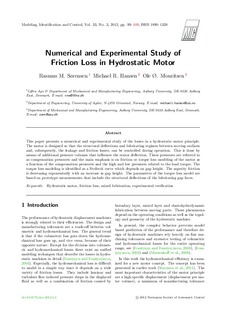| dc.contributor.author | Sørensen, Rasmus M. | |
| dc.contributor.author | Hansen, Michael R. | |
| dc.contributor.author | Mouritsen, Ole Ø. | |
| dc.date.accessioned | 2013-02-14T10:16:49Z | |
| dc.date.available | 2013-02-14T10:16:49Z | |
| dc.date.issued | 2012 | |
| dc.identifier.citation | Sørensen, R. M., Hansen, M. R., & Mouritsen, O. Ø. (2012). Numerical and experimental study of friction loss in hydrostatic motor. Modeling, Identification and Control, 33(3), 99-109. doi: 10.4173/mic.2012.3.2 | no_NO |
| dc.identifier.issn | 0332-7353 | |
| dc.identifier.uri | http://hdl.handle.net/11250/136932 | |
| dc.description | Published version of an article in the journal: Modeling, Identification and Control. Also available from the publisher at: http://dx.doi.org/10.4173/mic.2012.3.2 Open access | no_NO |
| dc.description.abstract | This paper presents a numerical and experimental study of the losses in a hydrostatic motor principle. The motor is designed so that the structural deflections and lubricating regimes between moving surfaces and, subsequently, the leakage and friction losses, can be controlled during operation. This is done by means of additional pressure volumes that influence the stator deflection. These pressures are referred to as compensation pressures and the main emphasis is on friction or torque loss modeling of the motor as a function of the compensation pressures and the high and low pressures related to the load torque. The torque loss modeling is identified as a Stribeck curve which depends on gap height. The asperity friction is decreasing exponentially with an increase in gap height. The parameters of the torque loss model are based on prototype measurements that include the structural deflections of the lubricating gap faces. | no_NO |
| dc.language.iso | eng | no_NO |
| dc.publisher | Norwegian Society of Automatic Control | no_NO |
| dc.subject | experimental verification | no_NO |
| dc.subject | friction loss | no_NO |
| dc.subject | hydrostatic motor | no_NO |
| dc.subject | mixed lubrication | no_NO |
| dc.title | Numerical and experimental study of friction loss in hydrostatic motor | no_NO |
| dc.type | Journal article | no_NO |
| dc.type | Peer reviewed | no_NO |
| dc.subject.nsi | VDP::Technology: 500 | no_NO |
| dc.source.pagenumber | 99-109 | no_NO |
| dc.source.volume | 33 | no_NO |
| dc.source.journal | Modeling, Identification and Control | no_NO |
| dc.source.issue | 3 | no_NO |
| dc.identifier.doi | 10.4173/mic.2012.3.2 | |
